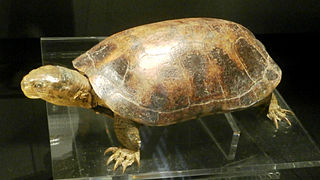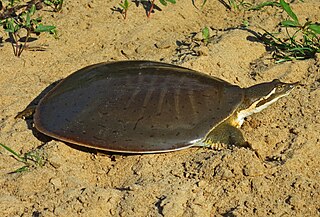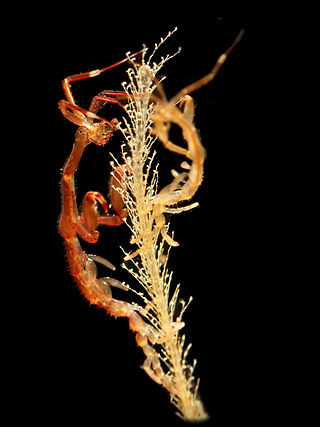
Amphipoda is an order of malacostracan crustaceans with no carapace and generally with laterally compressed bodies. Amphipods range in size from 1 to 340 millimetres and are mostly detritivores or scavengers. There are more than 9,900 amphipod species so far described. They are mostly marine animals, but are found in almost all aquatic environments. Some 1,900 species live in fresh water, and the order also includes the terrestrial sandhoppers such as Talitrus saltator and Arcitalitrus sylvaticus.

Caprellidae is a family of amphipods commonly known as skeleton shrimps. Their common name denotes the threadlike slender body which allows them to virtually disappear among the fine filaments of seaweed, hydroids and bryozoans. They are sometimes also known as ghost shrimps.

Mauremys is a genus of turtles in the family Geoemydidae.

The yellow pond turtle, is a medium-sized, semiaquatic turtle in the family Geoemydidae. This species has a characteristic broad yellow stripe extending behind the eye and down the neck; the carapace ranges in color from grayish brown to brown, and the plastron is yellow or orange with black blotches along the outer edges. It is native to East Asia, ranging from central Vietnam and Laos, north through the coastal provinces of south and central China, with insular populations known from Taiwan, Hainan and the Ryukyu Islands. Although populations in the southern Ryukyus are thought to be native, populations in the northern and central Ryukyus, as well as central Japan, are believed to have been introduced as a result of imports from Taiwan.

The smooth softshell turtle is a species of softshell turtle of the family Trionychidae. The species is endemic to North America.
Azumamorula mutica, common name the smooth ricinula, is a species of sea snail, a marine gastropod mollusk in the family Muricidae, the murex snails or rock snails. It is the only species in genus Azumamorula.

Caprella is a large genus of skeleton shrimps belonging to the subfamily Caprellinae of the family Caprellidae. It includes approximately 170 species. The genus was first established by Jean-Baptiste Lamarck in his great work Système des animaux sans vertèbres (1801) to describe Cancer linearis and Squilla ventricosa.

Caprella mendax is a species of skeleton shrimp in the genus Caprella.

Caprella kominatoensis is a species of skeleton shrimp in the genus Caprella. It was described in 1986 by Ichiro Takeuchi for specimens from Amatsu-Kominato, Chiba Prefecture, Japan, and is closely related to C. decipiens.

Caprella bathytatos is a species of skeleton shrimp in the genus Caprella. It was described in 1998 by Joel W. Martin and Gary Pettit, who discovered it living on the mouthparts of the crab Macroregonia macrochira near hydrothermal vents in British Columbia.

Caprella mutica, commonly known as the Japanese skeleton shrimp, is a species of skeleton shrimp. They are relatively large caprellids, reaching a maximum length of 50 mm (2.0 in). They are sexually dimorphic, with the males usually being much larger than the females. They are characterized by their "hairy" first and second thoracic segments and the rows of spines on their bodies. Body color ranges from green to red to blue, depending on the environment. They are omnivorous highly adaptable opportunistic feeders. In turn, they provide a valuable food source for fish, crabs, and other larger predators. They are usually found in dense colonies attached to submerged man-made structures, floating seaweed, and other organisms.
Caprella tuberculata is a species of skeleton shrimp in the genus Caprella. It is native to the North Sea.

Caprella linearis is a species of skeleton shrimp in the genus Caprella. It is native to the North Atlantic, North Pacific, and the Arctic Ocean. It closely resembles Caprella septentrionalis with which it shares the same geographical distribution.

A shrimp is a crustacean with an elongated body and a primarily swimming mode of locomotion – typically belonging to the Caridea or Dendrobranchiata of the decapod order, although some crustaceans outside of this order are also referred to as "shrimp".

Brachiaria mutica is a species of grass known by the common names para grass, buffalo grass, Mauritius signal grass, pasto pare, malojilla, gramalote, parana, Carib grass, and Scotch grass. Despite its common name California grass, it does not occur in California; it is native to northern and central Africa and parts of the Middle East, where it is cultivated for fodder. It was introduced elsewhere and it is now cultivated throughout tropical regions of the world for this purpose.

Caprella equilibra is a species of skeleton shrimp in the family Caprellidae. It lives among other organisms on the seabed and occurs in both shallow and deep water in many parts of the world.

Caprella penantis is a species of skeleton shrimp in the family Caprellidae. It lives on the seabed in shallow water in many parts of the world. This species was first described in 1814 by the English zoologist William Elford Leach who named it Caprella penantis in honour of the Welsh naturalist Thomas Pennant. The type locality is Devon, England.

Caprella unica is a species of skeleton shrimp in the genus Caprella within the family Caprellidae. The larvae are plankton-like. They are relatively small, with two large and two small antennae. They only live in the sea, and are widely found in Cape Cod, Maine and Newfoundland.














